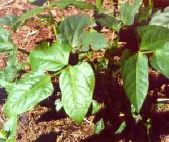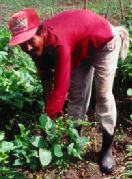Vigna unguiculata (Vigna sinensis)
Cowpeas, Black-Eyed Peas, Caupi,Frijol de Vaca, Frijo Mica, Feijão de Corda
Tropical/Subtropical


Introduction
Cowpea is an annual legume that was domesticated in West Africa. There are three basic subgroups of cowpeas; the common cowpea, the catjang and the yard-long bean. Black-eyed peas are a type of cowpea that came to the southeast U.S with the slave trade and remain popular in this region.
The cowpea is an important grain legume and is also an important leaf vegetable in much of Africa and parts of Asia. Cowpea leaves are produced on some commercial scale in 18 African countries and 7 Asian ones. Often cowpeas are grown for their leaves in high rainfall areas and for seeds in lower rainfall areas. According to James Duke in his Handbook of Legumes of World Economic Importance cowpea leaves can produce 9 times the calories, 15 times the protein, 90 times the calcium, and thousands of times more vitamin C and beta-carotene of cowpea seed.
Perhaps the best plant for intercropping with grains like sorghum and corn, cowpeas fix atmospheric nitrogen and improve the growth of plants nearby. Cowpeas are a multi-purpose crop with enormous potential to improve the health of people at risk of malnutrition.
Pros
- Well known to be edible: the leaves are eaten as vegetable in many African and Asian countries.
- Seeds easily available commercially and very easy to propagate
- Germinates well and grows very quickly compared to many tropical legumes enabling it to get over weeds with one cultivation
- Good yield of mild flavored leaf
- Fixes atmospheric nitrogen eliminating need for nitrogen fertilizer and creating a soil nitrogen surplus for the following crop.
- Excellent intercrop plant to use between rows of corn, cassava, bananas, or other crops. Two hectares of corn and cowpeas intercropped will usually produce about 30% more than one hectare of corn and one hectare of cowpeas. The intercropping of 4 rows of cowpeas between rows of bananas and plantains has shown a lot of promise. Since the weeds need to be cut from between the banana rows anyway, it makes sense to use that space for a nitrogen-fixing crop.
- Produces edible immature beans and dried beans that have commercial value
- Both beans and edible greens can be economically produced from the same parcel by planting cowpeas in rows 16 inches apart and letting them grow till the leaves begin to touch. Then every other row is harvested for greens without lowering bean yield.
- Cowpeas can be grown as a green manure crop and turned into the ground just before flowering. This adds nitrogen and organic matter and improves soil structure. It also has an unexpected benefit of dramatically lowering aluminum toxicity, which is a very serious problem in many tropical soils.
- Relatively drought resistant once established
- Cowpea foliage is one of the best sources for leaf concentrate or leaf protein extraction.
Cons
- Somewhat prone to virus
- Sensitive to frost and waterlogged or saline soil
- An annual that won't take repeated cuttings, needs replanting at least every 12 weeks
- Susceptible to diabrotica and galurucid beetle attacks, as well as root-knot nematodes and Striga gesnerioides, a parasitic weed. Susceptibility is greater in the humid tropics but growth rate is faster there as well.
Notes
- Leaf for Life expects a yield of 10 tons per hectare in 60 days during the rainy season, based on experience and reports from Nicaragua, Africa, and India. Of this, about 40% is stem, so we have 6 tons of actual leaf. Six tons of fresh cowpea leaf will yield about one ton (16–18%) of dried leaf. We can usually get in at least two crops without reliance on irrigation. This would provide enough leaf powder for 200,000 portions of 10 grams each; or enough to supply 800 children with a ten gram portion of dried leaf meal 5 days a week year round.
- A hectare in cowpea leaves should produce about 7.75 grams of iron per day or enough to meet the Recommended Daily Allowance for 775 children aged 4-6 years.
Approximate nutritional value of 10 grams (c. 1/3 ounce) of dried cowpea leaf, and % of US RDA for 4 6 year old. These figures are derived from averages from UN FAO 1968, and Imungi and Potter. They assume a 75 % loss of vitamin C and a 40% loss of betacarotene during drying.
| Protein | Fiber | Calcium | Iron | B Carotene | Vitamin C |
| 3.0 g | 1.2 g | 146 mg | 3.5 mg | 3.0 mg | 9 mg |
| 13% | 5% | 18% | 35% | 60% | 20% |
- Some African farmers believe that a moderate harvest of cowpea leaves and stem tips (about 2T/ha) at flowering increases seed yield, while removing over 4 t/ha reduces seed yield.
- When grown strictly as a leaf vegetable, a dense sowing of seedlings is harvested 3-6 weeks after planting by cutting at ground level or by uprooting. Planting for leaf yield should be at least twice as dense as a normal planting for bean yield.
- Cowpeas cut at 20 cm above the ground will regrow quickly but those cut at 5 cm will regrow slowly if at all.
- Cowpea seed should be inoculated with EL type rhizobia if cowpeas haven't been grown on the land in the past three years.
- Cowpea leaves are traditionallly dried in much of sub-Saharan Africa to provide a source of greens over the long dry season. Morogo is made in South Africa by boiling cowpea, amaranth, and melon leaves for one and half hour then kneading them into pulp and squeezed into golfball sized balls to dry in the open sun. In Malawi, leaves are dried for 2-3 hours then packed tightly into jars and boiled for 20 minutes. The softened leaves are then spread in the sun again for 2 -3 days; then they are rolled into 2 kg balls and stored for the dry season.
Research on cowpeas as a leaf crop is being done at:
International Institute of Tropical Agriculture
N.Q. Ng Head OYO Road
PMB 5320
Ibadan, NIGERIA
tel: 400300 400314 whose European contact is:
IITA
c/o Ms. Maureen Larkin, Carolyn House
26 Dingwall Rd.
Croydon CR9 3EE, UK
fax 44 81 681 8583.
They may be willing to provide test packets of cowpea varieties.
Seeds
- Widely available through farm supply stores in areas where it is commonly grown or in small quantities through mail order houses.
- Best commonly available foliage varieties in the US are probably Iron and Clay, Chinese Red, and Whippoorwill. Vita 7 was rated the best overall foliage variety, but seed is difficult to find.
Inoculant is available from:
Peaceful Valley Farm Supply
P.O. Box 2209
Grass Valley, CA 95945, USA
tel: 916–272–GROW
FAX: 916–272–4794
or
Liphatech
3101 W. Custer Ave.
Milwaukee, WI 53209, USA
tel: 414–462–7600
or from many larger seed dealers.
- Typical seed price $20 – 25 US for 50 lb (c.23 kg) sack.
Related Plants with Edible Leaves
Vigna umbellata (rice bean); V. mungo (black gram, urid); V. marginata
About 185 species of related leguminous plants produce leaves that are eaten to some extent by humans.